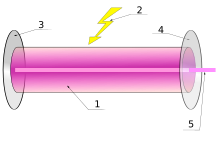Laser medium
A material that is suitable for generating laser light through stimulated emission is referred to as a laser medium (also laser-active medium ) . In addition to the pump source and resonator, it is one of the three essential elements of a laser, with the exception of the free electron laser (FEL), which is constructed completely differently from conventional lasers and works without a laser-active medium.
Typically, lasers are categorized according to their laser medium (see list of laser types ), as the medium (or the light-amplifying structure) in interaction with the resonator significantly determines the properties of a laser, such as the wavelength and thus the color , the maximum achievable in visible light Power and the pulse characteristics .
In general, it can be a laser-active medium
- a solid (e.g. doped glasses and crystals ), see solid-state laser
- a liquid (e.g. dye solutions ), see dye laser or
- a gas (e.g. helium-neon mixture , argon ), see gas laser .
A necessary prerequisite for the suitability of a material as a laser medium is the possibility of inversion of population by supplying external energy ( optical pumping ).
Not all lasers have a laser-active medium in the sense of a material; the population inversion can also be generated by means of structures (e.g. consisting of semiconductor material for diode lasers or quantum cascade lasers ).
Further information
- Gain Media in the Encyclopedia of Laser Physics and Technology (Engl.)
- F. Kneubühl, M. Sigrist: Laser . 7th edition. Vieweg + Teubner, Zurich 2008, ISBN 978-3-8351-0145-6 .
